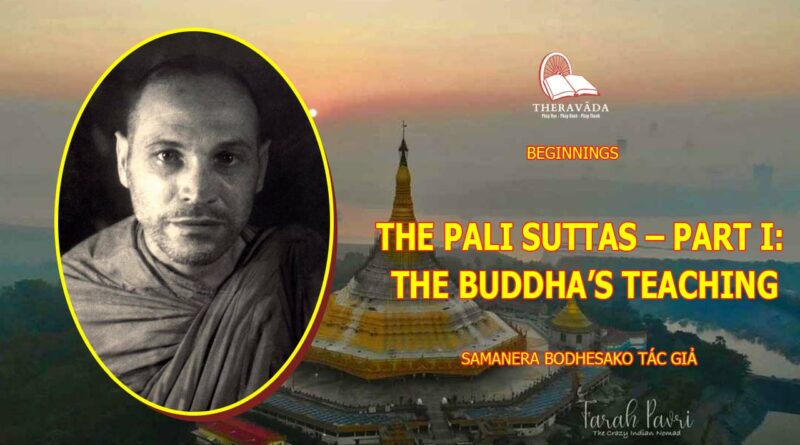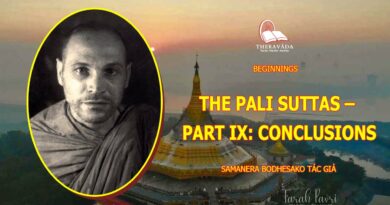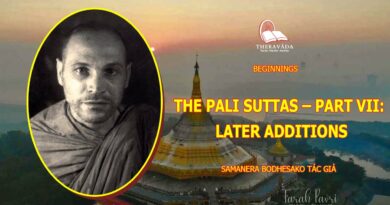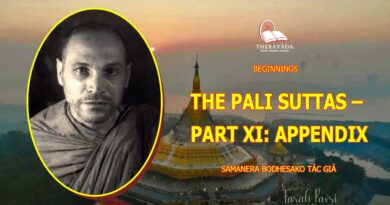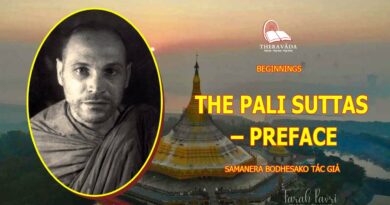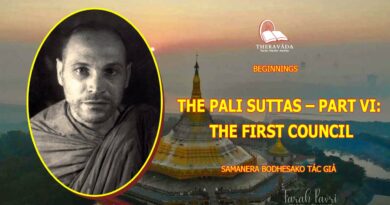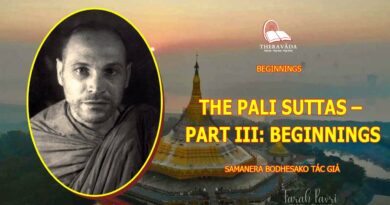Nội Dung Chính [Hiện]
BEGINNINGS: THE PALI SUTTAS
Where does one begin? This is obviously the first question. And when the issue at hand is the manifest need to explore and resolve the root-problem of our personal existence, then this question takes on a primacy in terms not only of sequence but of importance. One begins, of course, from where one is, for from where else can one begin? Herein the intelligent person, he who does not shrink from unpleasant truths, will acknowledge the problem. He may describe it in any of a number of ways — anxiety, loneliness, insufficiency, frustration, inconstancy, boredom, uncertainty, bondage, meaninglessness, impermanence, despair — but however it appears it will be seen, if it is seen at all, to be fundamental, for it is bound up in one way or another with a sense of one’s own mortality.
When we apprehend the ever-present possibility of our own immediate dying, — the impossible possibility, says Heidegger, — then any notions we may have about our golden and glittering prospects in the world will be seen to be illusory inasmuch as they, and we as well, end in death.[1] The gold is now seen for the leaden bondage that it really is, the alchemy has failed, and we see ourselves to be in perpetual subjugation to the uncertainty inherent in the world. And we then feel, deeply, the need to act.
There must be release from this overwhelming fact of our own mortality: we cannot believe otherwise. But, equally certain, we don’t know the way to that release else, surely, we would already have taken it. Can we find this way? Fine and earnest people have tried before us — that we know — and have admitted failure. Our task, then, cannot be easy. But having recognized our existence in this world as inherently unsatisfactory, we now sense the utter necessity of seeking the means to transcend it. We are unwilling to plunge yet again — again! — into that endless round of pastimes wherein most people waste their lives in the effort to avoid facing the truth of their own mortal existence. Although we don’t know the way ourselves, it is yet possible that there exists some teacher, some teaching, to provide guidance. And so we look about us, and we find… orators, teachers, therapists, hucksters, salvation-mongers, apostles, psychologists, preachers, gurus, swamis, saviours and salesmen by the score, each offering his own brand of salvation. And thus we arrive again at our original question: where does one begin?
They can’t all be right. If it were so easy, we would have no need of a teacher, for we and everyone else would already have done the work ourselves. Besides, many of these teachings, anti-teachings, disciplines, non-disciplines and weekends are manifestly in contradiction with one another and sometimes even with themselves, both in doctrine and in practice. And therefore, unless we abandon consistency of both thought and effort, we must acknowledge the importance of choosing among them intelligently, unless we believe them to be uniformly mistaken, in which case the choice would again seem unimportant. For the choice we make will be our beginning, and from that beginning — made wisely or foolishly — everything else will follow.
Nor need we believe ourselves to be totally incompetent to make that choice. For although it is a truism that, as is sometimes argued, the only way to know for certain which teaching or teachings are in accordance with truth is to see truth for oneself, yet we can even now make a reasonable assessment of these teachings. To be unenlightened is not to know nothing; for were that the case we should not long survive in this uncertain world. We are free from confusion at least to the extent that we now see the need to free ourselves from it totally.[2] Having acknowledged the problem, we can sort out from among those teachings which offer themselves to us those that at least address themselves to that problem from those that merely pander in one way or another to the world’s proclivity for any comfortable, or even uncomfortable, notion in order to avoid facing the problem. For underlying each practice will be a doctrine or general attitude, and from this we can come to know the general nature of each teaching and can thereby separate the relevant from the superfluous. And thus it is that, eventually, we will come to the Buddha’s Teaching.
The Buddha’s Teaching
The Buddha’s Teaching: what images it conjures — compassion, serenity, acquiescence, wisdom, bliss, selflessness. In such terms is it often described, even from afar, even among those who know only its general outlines. Such is the image of this Teaching that is in world-wide circulation; and with such qualities does it invite seekers of peace to take a closer look. With such a reputation it may perhaps prove to be the fount of advice and guidance we so need. And therefore we eagerly approach it, to find… Theravada Buddhism, Mahayana, Ch’an, Korean Zen, Vajrayana, Tantric and dozens of other sects and sub-sects, large and small, new and old, all claiming to be the Teaching of the Buddha. And so it is that again we return to out original question: Where does one begin?
Are these schools different in name only? Or do they differ as well in attitude, approach, doctrine and practice? Is all one? Is all a diversity? Does nothing really exist? Does everything really exist? Or are these disparate views merely worldly wisdom, best abandoned in favour of seeing that “Whatever is arises dependent on conditions and is not without conditions”? Must we save others before we will be able to save ourselves? Or must we save ourselves before we will be in a position to save others? Is everything already perfect? Or is it only suffering that arises, suffering that ceases? Do we all have Buddha Nature? Or is all existence empty, without essence? Will we all eventually arrive at eternal salvation? Or do only those achieve liberation who see that all conditions are impermanent? Is nibbana (Skt. nirvana) to be found in samsara, the round of existences, or are they mutually exclusive? What is the sound of one hand clapping?
If we accept that truth, whatever else it may be, is at least not self-contradictory, then the question necessarily arises: which among these paths, diverse and often at odds with one another, will offer us that way to liberation which we seek?[3] And if these teachings are all different — or even if they are not — which of them is that Teaching set forth 2,500 years ago by a certain member of the Gotama family of the Sakyan clan, in northern India, known today as the Awakened One, the Buddha? If it were only possible to come to a reasonable judgement on this point, then we might be able with one stroke to cut through the tangle of confusion we meet with when we inquire into the nature of “Buddhism”. For we will then find — if the Teaching lives up to its reputation — one coherent, sufficient and, above all, relevant Teaching which can serve as a standard in our inquiry into the nature of our mortal existence. And perhaps this is possible.
We know that the Pali Suttas — the discourses in the Pali language — are acknowledged by all Buddhist schools to be the oldest record we have of the Buddha’s Teaching. We know that nearly a century ago the scholars of the West performed an about-face from their original majority position and now fully acknowledge the primacy, as regards age, of those Suttas. But we also know that certain objections have been raised with regard to the origin and transmission of those discourses. Are these objections valid? What is the difference here, if any, between “oldest” and “original”? How trustworthy are these texts as we now have them? With what degree of confidence are we able to ascertain the truth of the matter? Fortunately, it is possible to know, with reasonable confidence, the way in which these texts were first gathered together and then handed down to us. Let us inquire.
Source: Budsas.net

